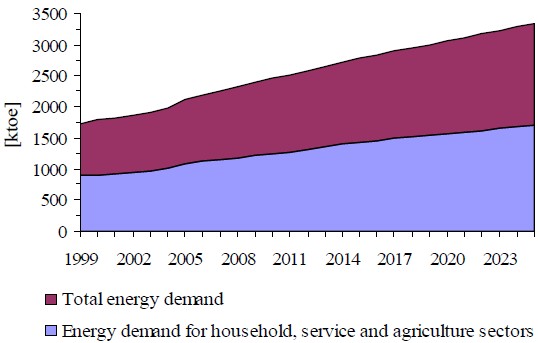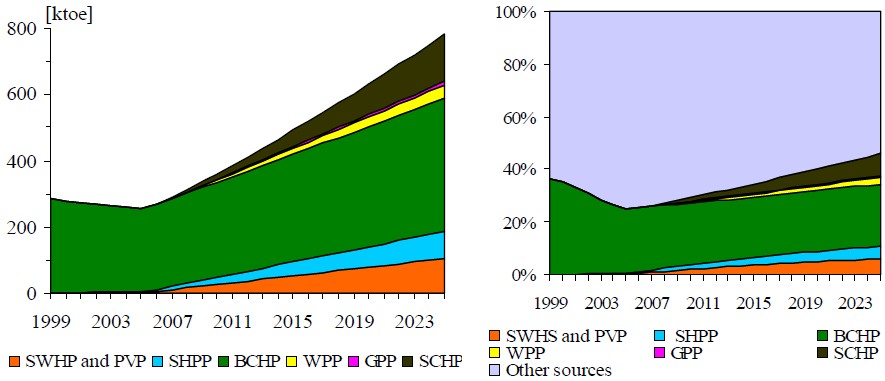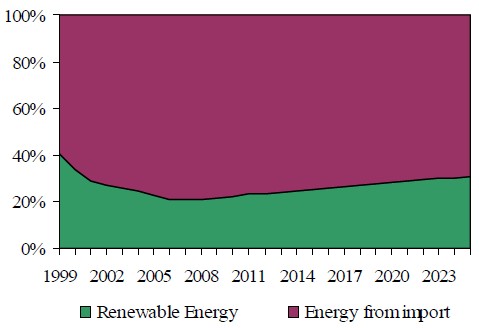The forecast of the RES percentage in the overall fuel mix in Albania

Figure 24 Energy demand for household, service and agricultural sector in the total energy
demand foreseen
One of the main goals of this study is to assess the energy amount that can be provided by the renewable energy. We stick on this study on the renewable energy technologies that can be applied in the household, service and agricultural sector. Taking into consideration the above goal the amount of energy provided by the renewable energy in the before mention sectors is analysed below. The figure shows the total energy demand foreseen for the household, service and agriculture sectors.
As it is shown in the figure the total energy demand in the household, service and agriculture sector will cover over 50% of the total energy demand. The analyses will be focused exactly in this energy demand, which can be provided from the renewable energy.
Contribution of each RET on the energy demand projection
The study of E. Hido informs that the solar water heating systems (SWHS) have generated 3.8 ktoe (44,2 GWh) until 2005. Meanwhile, according to the forecast done until 2025, it is supposed that the contribution from the systems will go up to 100 ktoe (1163 GWh). Therefore, in 2025 the generated energy from SWHS will be 26 times more than in 2005 (Hido 2006). The above data on the penetration of SWHS have been based on the penetration stage of the solar energy in the two sectors: household and service. The penetration of the solar energy in the household sector has been calculated in an amount of 16% in the whole country (in 2025). More specifically, the country is divided in three areas according to the heating degree days. Thus, the first area had a penetration of 21%, the second one 15% and the third area of 12%. The penetration of the solar energy in the service sector has been assessed in 15% in the public services and 27 % in the private ones.
According to the study of D. Profka, the photovoltaic centrals that produce electricity from the solar energy PVPP have not penetrated so far, except for a pilot project. Actually, there have been constructed around 5 kW. Meanwhile the forecast until 2025 implies that the PVPP (need of the isolated systems like the costal lighthouses and different the antennas for the mobile phone, radio and televisions) will contribute with a production of 4.3 ktoe (50 GWh). Thus, in 2025 the energy produced from PVPP will be 4.3 times more than in year 2005 (Profka 2006).
As a conclusion, the system that use solar energy can cover 7,8% of the total energy demand of the three sectors together (household, service and agriculture) or 4,12% of the import needs in 2025 in case of applying the mentioned scenario.
According to the analyses from S. Xhelepi, it concludes that until 2006 the SHPP have generated 1,7 ktoe around 20 GWh. Meanwhile, the optimistic forecasts imply that these plants will generate around 81,7 ktoe (950 GWh) in 2025, which means that the energy produced will be 48 times more than in 2005. As a conclusion, SHPP can cover up to 6,1 % of the energy demand in the three sectors considered or 3,23% of the import needs in 2025 (Xhelepi 2006).
According to the study of A.Hizmo, the contribution of biomass until 2005 has been 285 ktoe (3314 GWh). This is mainly dedicated to the use of fire woods, the only actual selection being used. Furthermore, he foresees that the plants using this energy will contribute by generating around 400 ktoe (4650 GWh) in year 2025, or 1,6 times more than in year 2005 (Hizmo 2006).
Contribution of biomass is mainly based on more efficient usage of the fire woods. Actually, the average yield of wood heaters is 35-40% and it is foreseen that the heaters of 75-85% yield will penetrate in 2025. The penetration value of the fire woods is calculated based on the annual production of the forests and the sector needs of the household, service, and agriculture demand. This process will have a double profit: it will enable the sustainable usage of the forests and it will considerably decrease the local pollution (SO2, CO). It has been supposed that the penetration of biomass will be increased by using the agriculture biomass (animal breeding, the so-called energy plants) in energy production of green houses and the especially in the energy production (as a secondary product) as a result of the urban waste treatment. The biomass can cover up to 29.8% of the energy demand in the three sectors considered together or 15,82% of the import needs in 2025.
According to the study of P. Mitrushi, it results that the wind energy contribution has not existed until 2005. There have been some attempts to install pilot wind turbines. Nevertheless, the actual contribute of this energy source is zero. It has been foreseen that the penetration of these plants (WPP) will generate energy up to 43 toe (500 GWh) until 2025. P. Mitrushi assumes in his study a concept-idea of the construction of Wind Electro Centrals in the Adriatic Costal area. The project looks more feasible in this area than in other ones because of the great energeticecologic-economic impact. As a conclusion we can say that WPP can cover up to 3,2% of the energy needs in the three sectors considered together or 1,7% of the import needs for year 2025 (Mitrushi 2006).
A Frasheri and M. Mico presents in their studies that the contribution of geothermic energy has not existed until 2005. It is expected that this energy source will cover 10 ktoe (116,3 GWh). It is concluded that, the geothermic plants can cover up to 0,7% of the energy demand in the three sectors or 0,4% of the import needs for year 2025 (Frasheri 2006).
The energy supply improvement, the reduction of electric and thermo energy import, the promotion of the new technologies as, DH & CHP (District Heating & Combined Heat and Power) in the service and residential sector are the main objectives of B. Islami’s study.
A calculation of the thermo energy provided by SCHP has been done by taking into consideration its penetration of 6% in household sector and 10% in the service sector until 2025. According to this study, the energy produced by SCHP will be 144 ktoe (1675 GWh) in 2025. Therefore, the SCHP can cover up to 10,7% of the energy demand of the three sectors or 5,7% of the import needs in 2025 (Islami 2006).


